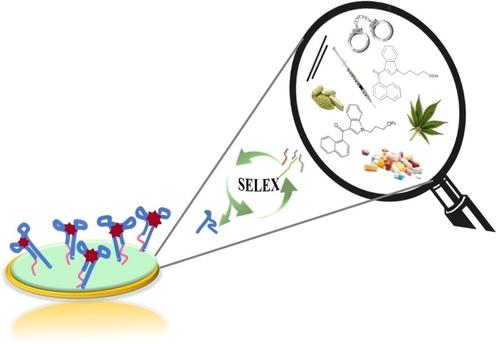当前位置:
X-MOL 学术
›
Electroanalysis
›
论文详情
Our official English website, www.x-mol.net, welcomes your feedback! (Note: you will need to create a separate account there.)
Sensor Platform with a Custom‐Tailored Aptamer for Diagnosis of Synthetic Cannabinoids
Electroanalysis ( IF 3 ) Pub Date : 2020-01-07 , DOI: 10.1002/elan.201900670 Simge Balaban 1 , Ezgi Man 1 , Ceren Durmus 1 , Gulsah Bor 1 , Ayse Elcin Ceylan 1 , Z. Pinar Gumus 2 , Serap Evran 1 , Hakan Coskunol 3 , Suna Timur 1, 2
Electroanalysis ( IF 3 ) Pub Date : 2020-01-07 , DOI: 10.1002/elan.201900670 Simge Balaban 1 , Ezgi Man 1 , Ceren Durmus 1 , Gulsah Bor 1 , Ayse Elcin Ceylan 1 , Z. Pinar Gumus 2 , Serap Evran 1 , Hakan Coskunol 3 , Suna Timur 1, 2
Affiliation

|
Synthetic cannabinoids (SCs) are the large group of abused drugs and detection of them is still a challenge. Hence, new methods for analysis of SCs are being investigated. We aimed to develop a novel system for selective analysis of SCs. First, various custom‐tailored aptamers against the target SCs were selected through GO‐SELEX process. Toggling between different SC analytes during successive rounds of selection was performed to generate cross‐reactive aptamers. Then, the amino‐capped aptamers were synthesized and easily attached to the cysteamine‐covered gold electrodes. Analytical parameters and selectivity of the aptasensors were compared by using electrochemical techniques. After comparison of the analytical features and selectivity towards target analytes, one of the aptamers designated as Apta‐1 was chosen for further measurements. The aptasensor was tested by using differential pulse voltammetry technique against JWH‐018 (5‐pentanoic acid), selected as a model for SCs. The linearity and limit of detection were determined as 0.01–1.0 ng/mL and 0.036 ng/mL. Finally, sample application in synthetic urine samples was successfully performed with standard addition method, as confirmed by LC‐QTOF/MS. JWH‐018 (4‐hydroxypentyl), JWH‐073 (3‐hydroxybutyl), JWH‐250 (5‐hidroxypentyl) and HU‐210 were used to test the selectivity of the aptasensor and the system was shown to recognize all these SCs. Also other illegal drugs did not significantly interfere with the signal responses.
中文翻译:

带有定制量身定制的传感器的传感器平台,可用于合成大麻素的诊断
合成大麻素(SCs)是滥用药物的大类,如何检测仍然是一个挑战。因此,正在研究用于SCs分析的新方法。我们旨在开发一种新颖的系统,用于SC的选择性分析。首先,通过GO-SELEX流程选择了针对目标SC的各种量身定制的适体。在连续选择过程中,在不同SC分析物之间进行切换以生成交叉反应的适体。然后,合成了氨基封端的适体,并易于连接到半胱胺覆盖的金电极上。使用电化学技术比较了适体传感器的分析参数和选择性。在比较分析特征和对目标分析物的选择性后,选择了一种名为Apta-1的适体进行进一步测量。通过使用差分脉冲伏安技术针对JWH-018(5-戊酸)选择了适体传感器,该模型被选作SC的模型。线性和检出限确定为0.01–1.0 ng / mL和0.036 ng / mL。最后,如LC-QTOF / MS所证实的,通过标准添加方法成功地将样品应用于合成尿液样品。使用JWH‐018(4-羟基戊基),JWH‐073(3-羟基丁基),JWH‐250(5-羟基羟戊基)和HU‐210来测试适体传感器的选择性,并显示该系统可识别所有这些SC。另外,其他非法药物也没有明显干扰信号响应。036 ng / mL。最后,如LC-QTOF / MS所证实的,通过标准添加方法成功地将样品应用于合成尿液样品。使用JWH‐018(4-羟基戊基),JWH‐073(3-羟基丁基),JWH‐250(5-羟基羟戊基)和HU‐210来测试适体传感器的选择性,并显示该系统可识别所有这些SC。另外,其他非法药物也没有明显干扰信号响应。036 ng / mL。最后,如LC-QTOF / MS所证实的,通过标准添加方法成功地将样品应用于合成尿液样品。使用JWH‐018(4-羟基戊基),JWH‐073(3-羟基丁基),JWH‐250(5-羟基羟戊基)和HU‐210来测试适体传感器的选择性,并显示该系统可识别所有这些SC。另外,其他非法药物也没有明显干扰信号响应。
更新日期:2020-01-07
中文翻译:

带有定制量身定制的传感器的传感器平台,可用于合成大麻素的诊断
合成大麻素(SCs)是滥用药物的大类,如何检测仍然是一个挑战。因此,正在研究用于SCs分析的新方法。我们旨在开发一种新颖的系统,用于SC的选择性分析。首先,通过GO-SELEX流程选择了针对目标SC的各种量身定制的适体。在连续选择过程中,在不同SC分析物之间进行切换以生成交叉反应的适体。然后,合成了氨基封端的适体,并易于连接到半胱胺覆盖的金电极上。使用电化学技术比较了适体传感器的分析参数和选择性。在比较分析特征和对目标分析物的选择性后,选择了一种名为Apta-1的适体进行进一步测量。通过使用差分脉冲伏安技术针对JWH-018(5-戊酸)选择了适体传感器,该模型被选作SC的模型。线性和检出限确定为0.01–1.0 ng / mL和0.036 ng / mL。最后,如LC-QTOF / MS所证实的,通过标准添加方法成功地将样品应用于合成尿液样品。使用JWH‐018(4-羟基戊基),JWH‐073(3-羟基丁基),JWH‐250(5-羟基羟戊基)和HU‐210来测试适体传感器的选择性,并显示该系统可识别所有这些SC。另外,其他非法药物也没有明显干扰信号响应。036 ng / mL。最后,如LC-QTOF / MS所证实的,通过标准添加方法成功地将样品应用于合成尿液样品。使用JWH‐018(4-羟基戊基),JWH‐073(3-羟基丁基),JWH‐250(5-羟基羟戊基)和HU‐210来测试适体传感器的选择性,并显示该系统可识别所有这些SC。另外,其他非法药物也没有明显干扰信号响应。036 ng / mL。最后,如LC-QTOF / MS所证实的,通过标准添加方法成功地将样品应用于合成尿液样品。使用JWH‐018(4-羟基戊基),JWH‐073(3-羟基丁基),JWH‐250(5-羟基羟戊基)和HU‐210来测试适体传感器的选择性,并显示该系统可识别所有这些SC。另外,其他非法药物也没有明显干扰信号响应。


























 京公网安备 11010802027423号
京公网安备 11010802027423号